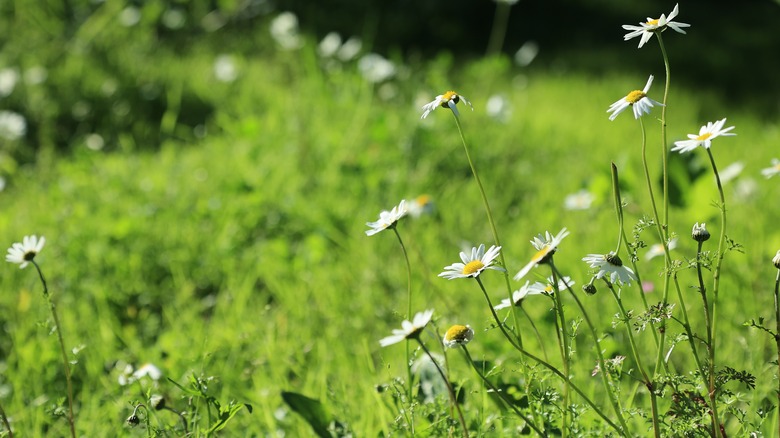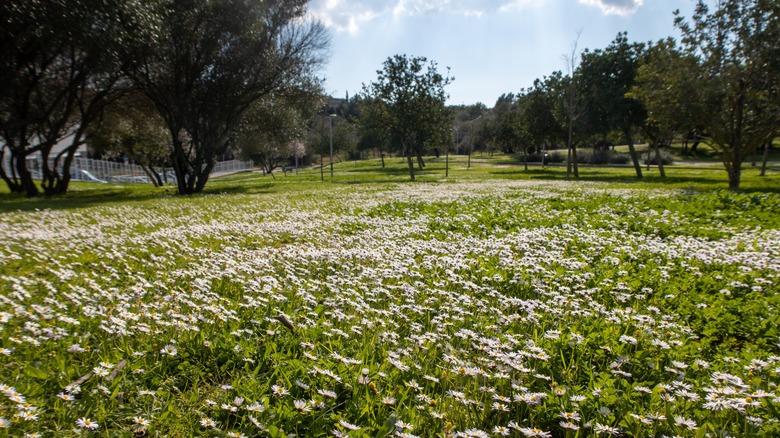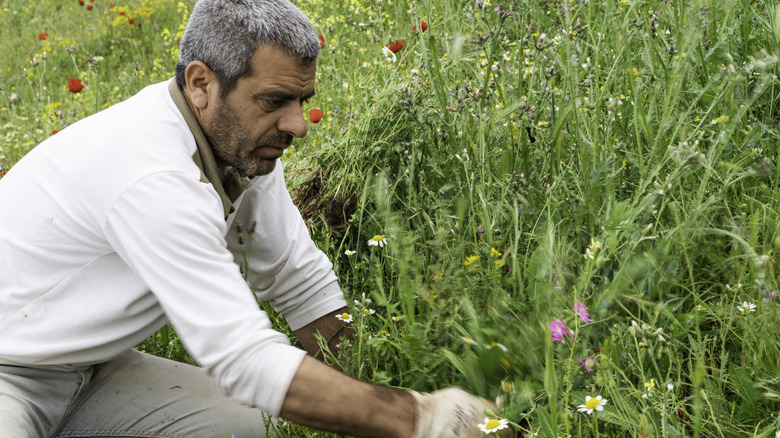This Daisy Variety Is Stunning, But It Can Wreak Havoc On Your Yard
We wouldn't be surprised if you're familiar with ox-eye daisies. After arriving in the U.S.A. centuries ago, they've made their way into home gardens and wild meadows across the country. They're enduringly attractive to gardeners because they require little care, are relatively pest-resistant, and the hippy-esque white-petaled, yellow-centered flowers look undeniably pretty in a vase on the mantle. Unfortunately, the ox-eye daisy is also a menace for these very same reasons, as well as its fast-growing rhizomatic root system and plentiful seed heads. Numerous invasive species, noxious weed, and quarantine lists feature it, including (but not limited to — the lists are changing all the time) California, Colorado, Montana, Utah, Washington, and some counties in Idaho.
This deceptively sweet plant is native to Europe; in its natural habitats, it causes little trouble. However, that's far from the case here in the U.S. The ox-eye daisy (Leuceanthemum vulgare) was introduced to American home gardens way back in the 1800s (the first official sighting was in Michigan in 1870), heralded as one of many types of daisies that will look perfect in your flower garden. It escaped the confines of its white picket fence in no time, and today, it out-competes native flora in the same ecological niche and threatens the local insects and animals that feed and live on them. Proud lawn owners are far from fans of ox-eye: it takes over a yard quickly, leaving little room for turf grass. Farmers feel much the same since it spreads agricultural diseases.
Ox-eye daisies are troublingly successful
Ox-eye daisy patches get out of control fast; the plant is built for success. In optimal conditions (that is, rich, soggy soil and sun), a single plant can produce as many as 26,000 seeds. Even its lowest output at 1,300 seeds — say, when growing in poor soil and shade — is a lot. The seeds lie dormant under the soil for up to 40 years, germinate in pretty much any conditions, and the flowers and flowerheads last through the winter in some areas, letting seeds fly the entire time. It also spreads by rhizomes, which can grow outwards from the parent plant or even from cut stem pieces.
Agricultural pastures are one of this daisy's favorite habitats (along with road verges, abandoned sites, riversides, railway lines, crop fields, woods, lawns, and residential gardens), so the fact that grazing animals like cows and deer aren't fans of eating it doesn't help. Plus, if they do happen to nibble a seed head, the seeds easily survive their digestive journey. If your lawn is filled with ox-eye daisies, hitting them with your lawnmower blades will not help. The plant can even spread diseases and pests like aster yellows and nematodes. The result — little space left in an area for any other plant, like native wildflowers — has led to ox-eye earning the "invasive species" title in many places. The daisies often end up in home gardens through wild dispersal, but it's equally possible you planted one intentionally or not.
How it arrived and how to get rid of it
This successful daisy thrives in USDA Hardiness Zones 3a to 8b, which covers most of the U.S.A., and its sale is restricted in only a few states. The plant goes by other names, including dog daisy, Marguerite, field daisy, white daisy, poorland flower, and moonpenny, so you may not have realized what you were buying or what that cutting your neighbor gave you actually was. Ox-eye, like other daisies, is beloved as an April birth flower. Bees and other pollinators are attracted to the blooms, and people add the plant to pollinator-friendly gardens. It's also commonly included in wildflower seed mixes.
Whichever way ox-eye daisies arrived, you can get rid of them. Organic methods include hand-pulling seedlings and plants, deadheading (cutting off) the flowers before they go to seed, and applying a deep mulch layer to any patch of bare soil to stop fallen seeds from germinating. When weeding, dig deep to get all the roots and throw away or burn plant parts. Don't compost them, or you risk spreading the plant again. If you're still losing the battle, you could spot-spray rosettes with a systemic herbicide like glyphosate, 2,4-D, or a product with aminopyralid as the active ingredient.
Still want something daisy-like in your garden? If you're familiar with growing ox-eye daisies, you'll already know how to care for Shasta daisy plants. Other options include scentless chamomile (Tripleurospermum inodorum) and Echinacea purpurea cultivars 'White Swan' and 'Pow Wow White.'


